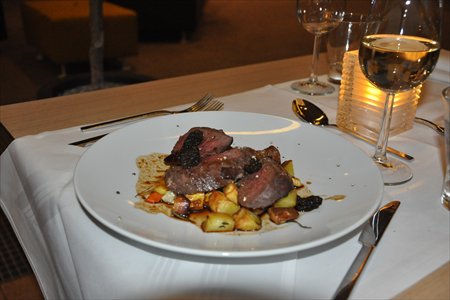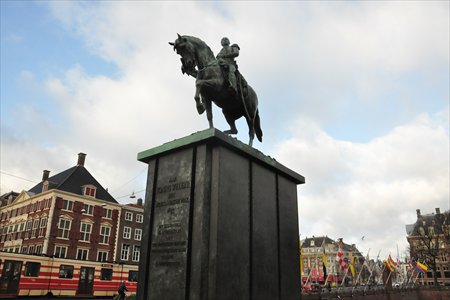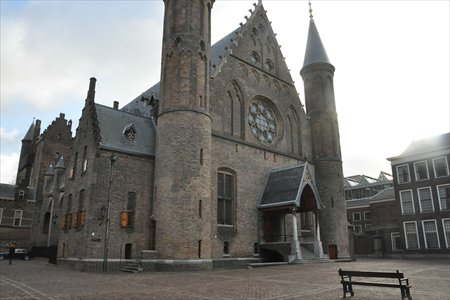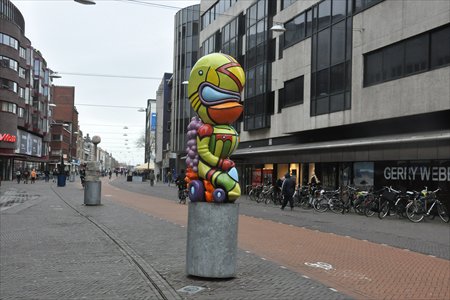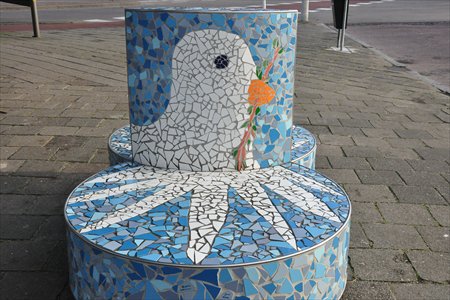HOME >>
LIFE, METRO BEIJING
The other side of The Hague
By Xu Liuliu Source:Global Times Published: 2012-3-9 21:35:00
Dutch fries Photo: Xiu Liuliu
Venison steak Photo: Xiu Liuliu
A statue of King William I Photo: Xiu Liuliu
The Knights' Hall
A sculpture in the street
Young Chinese people often like to quote the line by Chinese poet Hai Zi, "Facing the sea, with spring blossoms," when describing a dreamlike setting. The Dutch city known as The Hague, or Den Haag, west of Amsterdam, is one such place that calls to mind these memorable words. Costing only 4.9 euros and 30 minutes of your time, the train from Amsterdam to The Hague is worth the effort. In Amsterdam, I saw and experienced the artistic wonders and tolerance that make the Netherlands a terrific destination, but what would I find at my next stop, The Hague?
The Binnenhof
Unlike my experience in the capital city, I didn't see many travelers on the streets after exiting the city's central station. It is not a very big town, but it is certainly clean and quite. After checking into Hotel Mercure Den Haag Central, I congratulated myself for finding lodging that was so conveniently located that I could get nearly anywhere on foot.
While The Hague is not the capital city of the Netherlands, it is the seat of the Dutch government. Even Queen Beatrix of the Netherlands lives and works in the city. I decided that my first stop must be the old city center, the Binnenhof, which boasts an attractive and irregular group of buildings, some old and some new, built around a central courtyard.
In 1250, Count William II of Holland began building a castle, which was completed by his son and made into the family residence in 1291. From the time of Prince Maurice of Orange-Nassau (1567 - 1625), the Binnenhof was the residence of the Stadtholders.
Today it is the home of both chambers of the Dutch Parliament as well as a number of government departments. The rectangular complex of buildings has entrances at each end. At the east end of the central courtyard is the Knights' Hall, which is said to date back to the time of Floris V (1254 - 1296). While they're free to enter, you need to book in advance by telephone if you want to see inside the buildings.
Every year on the third Tuesday in September, the Queen drives to Parliament in her golden coach and delivers a speech from the throne to open the year's session. If you plan to travel to the Netherlands in September, be sure not to miss this spectacular scene of modern-day royalty in action.
But if you're like me and you come in other months, the Gothic Knights' Hall from the 13th century is certainly worth a visit. Again, do remember to book in advance, or you'll be left to stand outside gazing up at the outside of the building like me. In front there is a fountain, a perfect place for travelers to take photos with the hall's splendid architecture as the background. The charming setting is reminiscent of Rome's Trevi Fountain, with tourists making a wish and tossing a coin into the cool waters.
The Binnenhof is a different type of tourist attraction, as it still serves a governmental function. Part of the fun of a visit is seeing officials coming and going throughout the day amid the old architecture and sculptures. An equestrian statue of King William II (1792 - 1849) guards the main gate, which dates back to around 1600.
If you have read any Weibo posts lately, chances are you've come across discussions on Chinese movie star Tony Leung that when he feels tired and exhausted, he takes a plane to any European city and feeds the pigeons in a city square. While some mocked him for craving such an odd pastime, I found that in The Hague, life lends itself to such simple pleasures.
Near the main gate of the Binnenhof are scores of pigeons and birds pecking away at the ground. Slow afternoons can be passed peacefully with a bag of bread crumbs, bird watching, and people watching. It helps remind you to slow down and enjoy life.
Around the world, The Hague is known as the city of the Peace Palace and the International Court of Justice.
We have this concept of The Hague as the center of international justice, an idea that we formed back in our high school history classes. The Peace Palace is a great destination for anyone who likes to blend a bit of history into their travel itinerary. In front of it is the famous World Peace Flame, which is encircled by various stones donated by 198 countries. If you have time, you can follow the instructions to find the stone that China donated. Again, you need to book in advance to be allowed to enter the Peace Palace.
A colorful bench in front of the Peace Palace
Life's little pleasures
Here, in The Hague, you don't need to arrange a tight schedule crowded with must-see attractions, simply because there are few tourist sites as compared with Amsterdam. But for those who want a peaceful Dutch experience, the city will make your vacation with its relaxed mood.
The Hague offers a modern atmosphere, not only in its architecture but also in the sculptures that are to be found in every corner of the city. Some are quite contemporary, and it can be difficult to understand the meaning behind some of them. Once I asked a friend who'd lived there for years about a sculpture standing in front of City Hall. It features several animals including elephants and dog-like creatures. She said it is quite common to see unnamed sculptures throughout the city, and that even if they are difficult to grasp, "they are there to add beauty to our city, even if they are a little weird."
Wandering the city, you see sculptures everywhere, especially in China Town. Every five meters or so, you will find another construction ranging from a pile of several rocks to more complex figures that resemble aliens.
For fine arts, the city's thirty-some museums will offer you a chance to see plenty of Dutch works. Near the Binnenhof is the Mauritshuis, the mansion of Johan Maurits, governor-general of Dutch Brazil, Count of Nassau Siegen. Its collection consists of masterpieces from the Dutch Golden Age, including paintings by Vermeer, Rembrandt and Potter.
Spend an afternoon surrounded by master painters and then walk to a café on the Plein just opposite the Binnenhof. Remember, spending your vacation in a city doesn't mean you must rush from one attraction to another. The Hague is the perfect place to relax, doing as the locals do, and of course, eating like locals too.
Local cuisine
The streets of The Hague are teeming with yummy eats all over the city, boasting cuisine from nearly every corner of the world, from Chinese dishes to Brazilian BBQ. In China Town, you can enjoy Chinese dishes, although they are sweeter than those in China. But still you shouldn't miss the chance to have a taste of local delicacies. Dutch herring, or Hollandse nieuwe haring, is the one dish you must try, otherwise you won't have had a true taste of the Netherlands. People in Holland have been eating raw herring for over 600 years. The most traditional style is pickled herring with onions. Since I was a herring virgin, my friend was kind enough to suggest that I put the small fish between two slices of bread, called broodje haring, meaning "herring sandwich." She explained that this is the typical way for foreign travelers to have their first herring experience, joking that many give up after the first bite. But my first bite was splendid. The fish tasted great, and it wasn't too salty because of the bread. I ate the whole thing.
To be honest, in my everyday life I am not necessarily one to try something so unusual, but The Hague had an effect on me. I wanted to try the Dutch way of eating it: grasping the little fish at the tail and then letting it slide into your mouth.
I bravely picked up the herring, which had been cleaned, head removed, and pickled with a light, salty brine with raw onions, dropped it into my mouth, and chewed. It tasted and smelled fresh and delicious, and I was surprised that even without the bread it wasn't as salty as I'd expected.
All sorts of herring can be bought at street-side fish stalls throughout the city. One of my favorite suppliers was the stall at the main gate of the Binnenhof.
Another popular snack in The Hague is fries, or patat in Dutch. Thicker than their French counterpart, Dutch fries are twice-fried to make sure the outside is hot and crispy while the interior is soft and perfectly cooked.
The typical way of serving patat is in a cone with mayonnaise on top. Most places also have loads of other toppings to choose from like peanut sauce, ketchup and even onions. But for me, the classic mayonnaise was the best. A medium cone of patat is enough to treat an empty stomach.
After walking and exploring the city all day, all I wanted was a big meal. Since I didn't want to spend a lot of time hoofing around in search of a good restaurant, I decided to take dinner at my hotel's restaurant. It turned out to be a good decision.
I knew that in Europe, it is still a tradition to prize venison as a meat for festive occasions. I'd never tried it before, so I was pleased to find it on the menu. As I dug into my grilled deer steak with morel sauce, I savored the experience of living as the Dutch live.
Tips for travelers
1. Find a convenient and comfortable hotel in the city center. This will help save money as well as time. Taxis start at 7.5 euros and are available only in certain areas.
2. Check the weather and be sure to take an umbrella with you if you're going during the rainy season.
3. Do your homework before you go. Write down the Dutch names of the places you want to see or mark them on a map. Most street signs are in Dutch, but most young people speak English.
4. No need to arrange a tight schedule. Leave your days open for leisurely pace.
5. Be sure to stop for a cup of coffee on the Plein for a truly Dutch experience.
